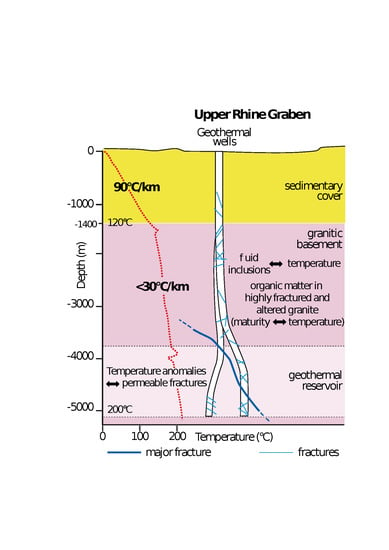How Can Deep Geothermal Projects Provide Information on the Temperature Distribution in the Upper Rhine Graben? The Example of the Soultz-Sous-Forêts-Enhanced Geothermal System
Abstract
:1. Introduction
1.1. Present-Day Thermal Anomalies
1.2. Organic Matter Maturity as an Evidence of Thermal History
2. Geological Setting
3. Material and Methods
3.1. Material
3.2. Methods
4. Results
4.1. Fresh Soultz Porphyritic Granite
4.2. Altered Soultz Porphyritic Granite
4.2.1. Petrography
4.2.2. Fluid Inclusions
4.2.3. Illite Dating
4.2.4. Organic Matter
4.2.5. Chemical Composition
4.2.6. Density, Porosity, Loss on Ignition
4.2.7. Calcite Content, Colorimetry and Magnetic Susceptibility
5. Discussion
5.1. Origin of Thermal Anomalies
5.2. Temperature Measurements in Geothermal Wells
5.3. Petrography of Fractured and Altered Zones, Their Stimulation and Implications on Temperature Distribution at a Local Scale
5.4. Integration of Results
5.5. Extrapolation to Other Sites in France
6. Conclusions
Author Contributions
Funding
Acknowledgments
Conflicts of Interest
References
- Moeck, I.S. Catalog of geothermal play types based on geologic controls. Renew. Sust. Energ. Rev. 2014, 37, 867–882. [Google Scholar] [CrossRef] [Green Version]
- Olasolo, P.; Juárez, M.C.; Morales, M.P.; Liarte, I.A. Enhanced geothermal systems (EGS): A review. Renew. Sust. Energ. Rev. 2016, 56, 133–144. [Google Scholar] [CrossRef]
- Levi, H. Die Produktionsgeschichte der Erdöllagerstätte von Pechelbronn unter besonderer Berücksichtigung ihres bergmännischen Abbaus. Erdöl Kohle Erdgas Petrochem 1962, 15, 169–176. [Google Scholar]
- Sittler, C. Les Hydrocarbures d’Alsace dans le context historique et géodynamique du fossé Rhénan [The case history of oil occurrence in the Rhine Rift Valley]. Bull. Centres Rech. Explor.Prod. Elf-Aquitaine 1985, 9, 335–371. [Google Scholar]
- Genter, A.; Traineau, H. Borehole EPS-1, Alsace, France: Preliminary geological results from granite core analyses for hot dry rock research. Sci. Drill. 1992, 3, 205–214. [Google Scholar]
- Ledésert, B.; Dubois, J.; Genter, A.; Meunier, A. Fractal analysis of fractures applied to Soultz-sous-Forêts Hot Dry Rock geothermal program. J. Volcanol. Geotherm. Res. 1993, 57, 1–17. [Google Scholar] [CrossRef]
- Dezayes, C.; Genter, A.; Valley, B. Structure of the low permeable naturally fractured geothermal reservoir at Soultz. C. R. Geosci. 2010, 342, 517–530. [Google Scholar] [CrossRef] [Green Version]
- Sausse, J.; Dezayes, C.; Dorbath, L.; Genter, A.; Place, J. 3D model of fracture zones at Soultz-sous-Forêts based on geological data, image logs, induced microseismicity and vertical seismic profiles. C. R. Geosci. 2010, 342, 531–545. [Google Scholar] [CrossRef]
- Vidal, J.; Genter, A.; Schmittbuhl, J. Pre- and post-stimulation characterization of geothermal well GRT-1, Rittershoffen, France: Insights from acoustic image logs of hard fractured rock. Geophys. J. Int. 2016, 206, 845–860. [Google Scholar] [CrossRef] [Green Version]
- Baujard, C.; Genter, A.; Dalmais, E.; Maurer, V.; Hehn, R.; Rosillette, R.; Vidal, J.; Schmittbuhl, J. Hydrothermal characterization of wells GRT-1 and GRT-2 inRittershoffen, France: Implications on the understanding of naturalflow systems in the rhine graben. Geothermics 2017, 65, 255–268. [Google Scholar] [CrossRef] [Green Version]
- Komninou, A.; Yardley, B.W.D. Fluid–rock interactions in the Rhine Graben: A thermodynamic model of the hydrothermal alteration observed in deep drilling. Geochim. Cosmochim. Acta 1997, 61, 515–531. [Google Scholar] [CrossRef]
- Sanjuan, B.; Millot, R.; Innocent, C.; Dezayes, C.; Scheiber, J.; Brach, M. Major geochemical characteristics of geothermal brines from the Upper Rhine Graben granitic basement with constraints on temperature and circulation. Chem. Geol. 2016, 428, 27–47. [Google Scholar] [CrossRef]
- Pauwels, H.; Fouillac, C.; Fouillac, A.-M. Chemistry and isotopes of deep geothermal saline fluids in the Upper Rhine Graben: Origin of compounds and water–rock interactions. Geochim. Cosmochim. Acta 1993, 57, 2737–2749. [Google Scholar] [CrossRef]
- Aquilina, L.; Pauwels, H.; Genter, A.; Fouillac, C. Water–rock interaction processes in the Triassic sandstone and the granitic basement of the Rhine Graben: Geochemical investigation of a geothermal reservoir. Geochim. Cosmochim. Acta 1997, 61, 4281–4295. [Google Scholar] [CrossRef]
- Aquilina, L.; Genter, A.; Elsass, P.; Pribnow, D. Evolution of Fluid Circulation in the Rhine Graben: Constraints from the Chemistry of the Present Fluids. In Hydrogeology of Crystalline Rocks; Stober, I., Bucher, K., Eds.; Chapter 4; Kluwer Academic Publishers: Dordrecht, Germany, 2000; pp. 177–203. [Google Scholar]
- Gérard, A.; Kappelmeyer, O. The Soultz-sous-Forêts project. Geothermics 1987, 16, 393–399. [Google Scholar] [CrossRef]
- Vidal, J.; Genter, A. Overview of naturally permeable fractured reservoirs in the central and southern Upper Rhine Graben: Insights from geothermal wells. Geothermics 2018, 74, 57–73. [Google Scholar] [CrossRef]
- Agemar, T.; Schellschmidt, R.; Schulz, R. Subsurface temperature distribution in Germany. Geothermics 2012, 44, 65–77. [Google Scholar] [CrossRef]
- Vernoux, J.F.; Lambert, M. Aquifères profonds d’Alsace. Constitution d’une base de données à usage géothermique. In Report BRGM/IMRG SGN/IRG ARG 93 T37; Bureau de Recherches Géologiques et Minières: Orléans, France, 1993; p. 41. [Google Scholar]
- Ledésert, B.; Joffre, J.; Amblès, A.; Sardini, P.; Genter, A.; Meunier, A. Organic matter in the Soultz HDR granitic thermal exchanger (France): Natural tracer of fluid circulations between the basement and its sedimentary cover. J. Volcanol. Geotherm. Res. 1996, 70, 235–253. [Google Scholar] [CrossRef]
- Sittler, C. Le pétrole dans le departement du Haut-Rhin. Bilan d’un siècle et demi de recherches et d’exploitation. Sci. Géol. Bull. 1972, 25, 151–161. [Google Scholar] [CrossRef]
- Clauser, C.; Villinger, H. Analysis of conductive and convective heat transfer in a sedimentary basin, demonstrated for the Rheingraben. Geophys. J. Int. 1990, 100, 393–414. [Google Scholar] [CrossRef]
- Freymark, J.; Bott, J.; Cacace, M.; Ziegler, M.; Scheck-Wenderoth, M. Influence of the Main Border Faults on the 3D Hydraulic Field of the Central Upper Rhine Graben. Geofluids 2019, 2019, 21. [Google Scholar] [CrossRef]
- Böcker, J.; Littke, R. Thermal maturity and petroleum kitchen areas of Liassic Black Shales (Lower Jurassic) in the central Upper Rhine Graben, Germany. Int. J. Earth. Sci. (Geol. Rundsch.) 2016, 105, 611–636. [Google Scholar] [CrossRef]
- Böcker, J.; Littke, R.; Forster, A. An overview on source rocks and the petroleum system of the central Upper Rhine Graben. Int. J. Earth. Sci. (Geol. Rundsch.) 2017, 106, 707–742. [Google Scholar] [CrossRef]
- Hillebrand, T.; Leythaeuser, D. Reservoir geochemistry of the Stockstadt oilfield. Org. Geochem. 1992, 19, 119–131. [Google Scholar]
- Ziegler, P.A. Geological Atlas of Western and Central Europe, 2nd ed.; Shell International Petroleum Mij BV: London, UK, 1990. [Google Scholar]
- Eisbacher, G.H.; Fielitz, W. Karlsruhe und seine Region. In Nordschwarzwald, Kraichgau, Neckartal, Südlicher Odenwald, Oberrhein-Graben, Pfälzerwald und Westliche Schwäbische Alb; Borntraeger Science Publishers: Stuttgart, Germany, 2010. [Google Scholar]
- Schumacher, M.E. Upper Rhine Graben: Role of preexisting structures during rift evolution. Tectonics 2002, 6, 1–17. [Google Scholar] [CrossRef]
- Dèzes, P.; Schmid, S.M.; Ziegler, P.A. Evolution of the European Cenozoic Rift System: Interaction of the Alpine and Pyrenean orogens with their foreland lithosphere. Tectonophysics 2004, 389, 1–33. [Google Scholar] [CrossRef]
- Grimm, K.I. Stratigraphie von Deutschland IX-Tertiär. In Teil 1: Oberrheingraben und Benachbarte Tertiärgebiete; Schweizerbart: Stuttgart, Germany, 2011. [Google Scholar]
- Villemin, T.; Bergerat, F. L’évolution structurale du Fosse rhénan au cours du Cénozoïque: Un bilan de la déformation et des effets thermiques de l’extension. Bull. Soc. geol. Fr. 1987, 8, 245–255. [Google Scholar] [CrossRef]
- Ledésert, B.; Hébert, R.; Grall, C.; Genter, A.; Dezayes, C.; Bartier, D.; Gérard, A. Calcimetry as a useful tool for a better knowledge of flow pathways in the Soultz-sous-Forêts Enhanced Geothermal System. J. Volcanol. Geotherm. Res. 2009, 181, 106–114. [Google Scholar] [CrossRef]
- Hettkamp, T.; Baumgartner, J.; Baria, R.; Gérard, A.; Gandy, T.; Michelet, S.; Teza, D. Electricity production from Hot Rocks. In Proceedings of the 29thWorkshop on Geothermal Reservoir Engineering, Stanford, CA, USA, 26–28 January 2004; pp. 184–193. [Google Scholar]
- Genter, A.; Homeier, G.; Chèvremont, P.; Tenzer, H. Deepening of GPK-2 HDR borehole, 3880–5090 m (Soultz-sous-Forêts, France)- Geological Monitoring. In Report BRGM R 40685; Bureau de Recherches Géologiques et Minières: Orléans, France, 1999; p. 44. Available online: http://infoterre.brgm.fr/rapports/RR-40685-FR.pdf (accessed on 12 November 2020).
- Genter, A.; Tenzer, H. Geological monitoring of GPK-2 HDR borehole, 1420–3880 m (Soultz-sous-Forêts, France). Soultz-sous-Forêts. In Report BRGM/RR-38629; Bureau de Recherches Géologiques et Minières: Orléans, France, 1995; p. 46. Available online: http://infoterre.brgm.fr/rapports/RR-38629-FR.pdf (accessed on 12 November 2020).
- Dezayes, C.; Genter, A.; Homeier, G.; Degouy, M.; Stein, G. Geological Study of GPK3 HFR Borehole (Soutlz-sous-Forêts, France). In BRGM/RP-52311-FR; Bureau de Recherches Géologiques et Minières: Orléans, France, 2003; p. 128. Available online: http://infoterre.brgm.fr/rapports/RP-52311-FR.pdf (accessed on 12 November 2020).
- Dezayes, C.; Genter, A.; Gentier, S. Fracture Network of the EGS Geothermal Reservoir at Soultz-sous-Forêts (Rhine Graben, France). GRC 2004, 11, 2004. [Google Scholar]
- Meller, C.; Ledésert, B. Is there a link between mineralogy, petrophysics, and the hydraulic and seismic behavior of the Soultz-sous-Forêts granite during stimulation? A review and re-interpretation of petro-hydromechanical data towards a better understanding of induced seismicity and fluid flow. J. Geophys. Res. Solid Earth 2017, 122, 9755–9774. [Google Scholar] [CrossRef] [Green Version]
- Velde, B. Electron microprobe analysis of clay minerals. Clay Miner. 1984, 19, 243–247. [Google Scholar] [CrossRef]
- Liewig, N.; Clauer, N. K-Ar dating of varied microtextural illite in Permian gas reservoirs, northern Germany. Clay Miner. 2000, 35, 271–281. [Google Scholar] [CrossRef]
- Clauer, N.; Liewig, N.; Ledésert, B.; Zwingmann, H. Evolution of Triassic sandstones from Vosges mountains-Rhine graben structural setting, NE France, based on K-Ar illite dating: Local and regional geodynamic implications. Clay Miner. 2008, 43, 363–379. [Google Scholar] [CrossRef]
- Glasmacher, U.A.; Tschernoster, R.; Clauer, N.; Spaeth, G. K-Ar dating of magmatic sericite crystallites for determination of cooling paths of metamorphic overprints. Chem. Geol. 2001, 175, 673–687. [Google Scholar] [CrossRef]
- Honty, M.; Uhlik, P.; Sucha, V.; Caplovicova, M.; Francu, J.; Clauer, N.; Biron, A. Smectite to illite alteration in salt-bearing bentonites; the East Slovak Basin. Clays Clay Miner. 2004, 52, 533–551. [Google Scholar] [CrossRef]
- Bonhomme, M.G.; Thuizat, R.; Pinault, Y.; Clauer, N.; Wendling, A.; Winkler, R. Méthode de datation potassium/argon. Appareillage et technique. In Note Technique de l’Institut de Géologie de Strasbourg; Institut de Géologie de Strasbourg: Strasbourg, France, 1975; p. 53. [Google Scholar]
- Bartier, D.; Ledésert, B.; Clauer, N.; Meunier, A.; Liewig, N.; Morvan, G.; Addad, A. Hydrothermal alteration of the Soultz-sous-Forêts granite (Hot Fractured Rock geothermal exchanger) into a tosudite and illite assemblage. Eur. J. Mineral. 2008, 20, 131–142. [Google Scholar] [CrossRef]
- Ledésert, B.; Berger, G.; Meunier, A.; Genter, A.; Bouchet, A. Diagenetic-type reactions related to hydrothermal alteration in the Soultz-sous-Forêts granite. Eur. J. Mineral. 1999, 11, 731–741. [Google Scholar] [CrossRef]
- Poty, B.; Leroy, J.; Jachimovicz, L. Un nouvel appareil pour la mesure des températures sous microscope: L’installation thermométrique Chaixmeca. Bull. Soc. Fr. Minéral. Cristallogr. 1976, 99, 182–186. [Google Scholar] [CrossRef]
- White, A.F.; Schulz, M.S.; Lowenstern, J.B.; Vivit, D.V.; Bullen, T.D. The ubiquitous nature of accessory calcite in granitoid rocks: Implications for weathering, solute evolution, and petrogenesis. Geochim. Cosmochim. Acta 2005, 69, 1455–1471. [Google Scholar] [CrossRef]
- Nédélec, A.; Trindade, R.; Peschler, A.; Archanjo, C.; Macouin, M.; Poitrasson, F.; Bouchez, J.-L. Hydrothermally-induced changes in mineralogy and magnetic properties of oxidized A-type granites. Lithos 2015, 212–215, 145–157. [Google Scholar] [CrossRef]
- Lapointe, P.; Morris, W.A.; Harding, K.L. Interpretation of magnetic susceptibility: A new approach to geophysical evaluation of the degree of rock alteration. Can. J. Earth Sci. 1986, 23, 393–401. [Google Scholar] [CrossRef]
- Harding, K.L.; Morris, W.A.; Balch, S.J.; Lapointe, P.; Latham, A.G. A comparison of magnetic character and alteration in three granite drill cores from eastern Canada. Can. J. Earth Sci. 1988, 25, 1141–1150. [Google Scholar] [CrossRef]
- Just, J.; Kontny, A.; De Wall, H.; Hirt, A.M.; Martín-Hernández, F. Development of magnetic fabrics during hydrothermal alteration in the Soultz-sous-Forêts granite from the EPS-1 borehole, Upper Rhine graben. Geol. Soc. Spec. Publ. 2004, 238, 500–526. [Google Scholar] [CrossRef]
- Genter, A.; Traineau, H. Analysis of macroscopic fractures in granite in the HDR geothermal well EPS-1, Soultz-sous-Forêts, France. J. Volc. Geotherm. Res. 1996, 72, 121–141. [Google Scholar] [CrossRef]
- Genter, A.; Traineau, H.; Ledésert, B.; Bourgine, B.; Gentier, S. Over 10 years of geological investigations within the HDR Soultz project, France. In Proceedings of the World Geothermal Congress 2000, Tohoku, Japan, 28 May–10 June 2000; pp. 3707–3712. [Google Scholar]
- Sanjuan, B.; Millot, R.; Dezayes, C.; Brach, M. Main characteristics of the deep geothermal brine (5 km) at Soultz-sous-Forêts (France) determined using geochemical and tracer test data. C. R. Geosci. 2010, 342, 546–559. [Google Scholar] [CrossRef]
- Sanjuan, B.; Millot, R.; Ásmundsson, R.; Brach, M.; Giroud, N. Use of two new Na/Li geothermometric relationships for geothermal fluids in volcanic environments. Chem. Geol. 2014, 389, 60–81. [Google Scholar] [CrossRef]
- Genter, A.; Traineau, H.; Dezayes, C.; Elsass, P.; Ledésert, B.; Meunier, A.; Villemin, T. Fracture analysis and reservoir characterization of the granitic basement in the HDR Soultz project. Geotherm. Sci. Technol. 1995, 4, 189–214. [Google Scholar]
- Sardini, P.; Ledésert, B.; Touchard, G. Quantification of microscopic porous networks by image analysis and measurements of permeability in the Soultz-sous-Forêts granite (Alsace, France). In Fluid Flow and Transport in Rocks—Mechanisms and Effects; chapter 10, 171–188; Jamtveit, B., Yardley, B., Eds.; Chapman &Hall: London, UK; Weinheim, Germany; New York, NY, USA; Tokyo, Japan; Melbourne, Australia; Madras, India, 1997; p. 319. [Google Scholar]
- Hébert, R.L.; Ledésert, B.; Bartier, D.; Dezayes, C.; Genter, A.; Grall, C. The Enhanced Geothermal System of Soultz-sous-Forêts: A study of the relationships between fracture zones and calcite content. J. Volcanol. Geotherm. Res. 2010, 196, 126–133. [Google Scholar] [CrossRef]
- Ledésert, B.; Hébert, R.; Genter, A.; Bartier, D.; Clauer, N.; Grall, C. Fractures, Hydrothermal alterations and permeability in the Soultz Enhanced Geothermal System. C. R. Geosci. 2010, 342, 607–615, special volume. [Google Scholar] [CrossRef]
- Freymark, J.; Sippel, J.; Scheck-Wenderoth, M.; Bar, K.; Stiller, M.; Fritsche, J.-G.; Kracht, M. The deep thermal field of the Upper Rhine Graben. Tectonophysics 2017, 694, 114–129. [Google Scholar] [CrossRef]
- Bächler, D.; Kohl, T.; Rybach, L. Impact of graben-parallel faults on hydrothermal convection––Rhine Graben case study. Phys. Chem. Earth 2003, 28, 431–441. [Google Scholar] [CrossRef]
- Baillieux, P.; Schill, E.; Edel, J.-B.; Mauri, G. Localization of temperature anomalies in the Upper Rhine Graben: Insights from geophysics and neotectonic activity. Int. Geol. Rev. 2013, 55, 1744–1762. [Google Scholar] [CrossRef]
- Baillieux, P.; Schill, E.; Abdelfettah, Y.; Dezayes, C. Possible natural fluid pathways from gravity pseudo-tomography in the geothermal fields of Northern Alsace (Upper Rhine Graben). Geotherm. Energy 2014, 2, 1–14. [Google Scholar] [CrossRef] [Green Version]
- Rummel, F.; Haack, U.; Gohn, E. Uranium, Thorium and Potassium Content and Derived Heat Production Rate (Yellow Report No. 6–9); Ruhr Universität: Bochum, Germany, 1988. [Google Scholar]
- Grecksch, G.; Ortiz, A.; Schellschmidt, R. Thermophysical Study of GPK2 and GPK3 Granite Samples: HDR Project Soultz Report; GGA-Bericht: Hannover, Germany, 2003. [Google Scholar]
- Pribnow, D. The Deep Thermal Regime in Soultz and Implications for Fluid Flow: HDR Project Soultz Report; GGA-Bericht: Hannover, Germany, 2000. [Google Scholar]
- Pribnow, D.; Clauser, C. Heat and fluid flow at the Soultz Hot Dry Rock system in the Rhine Graben. In Proceedings of the World Geothermal Congress, Kyushu-Tohoku, Japan, 28 May–10 June 2000. [Google Scholar]
- Pribnow, D.; Schellschmidt, R. Thermal tracking of upper crustal fluid flow in the Rhine Graben. Geophys. Res. Lett. 2000, 27, 1957–1960. [Google Scholar] [CrossRef]
- Bao, T.; Liu, Z.L. Thermohaline stratification modeling in mine water via double-diffusive convection for geothermal energy recovery from flooded mines. Appl. Energy. 2019, 237, 566–580. [Google Scholar] [CrossRef]
- Genter, A.; Evans, K.; Cuenot, N.; Fritsch, D.; Sanjuan, B. Contribution of the exploration of deep crystalline fractured reservoir of Soultz to the knowledgeof Enhanced Geothermal Systems (EGS). C.R. Geosci. 2010, 342, 502–516. [Google Scholar] [CrossRef]
- Dubois, M.; Ledésert, B.; Potdevin, J.L.; Vançon, S. Détermination des conditions de précipitation des carbonates dans une zone d’altération du granite de Soultz (soubassement du fossé rhénan, France): L’enregistrement des inclusions fluides. C. R. Acad. Sci. 2000, 331, 303–309. [Google Scholar] [CrossRef]
- Dubois, M.; Ayt Ougougdal, M.; Meere, P.; Royer, J.J.; Boiron, M.C.; Cathelineau, M. Temperature of palaeo- to modern self sealing within a continental rift basin: The fluid inclusion data (Soultz-sous-Forêts, Rhine graben, France). Eur. J. Mineral. 1996, 8, 1065–1080. [Google Scholar] [CrossRef]
- Smith, M.P.; Savary, V.; Yardley, B.W.D.; Valley, J.W.; Royer, J.J.; Dubois, M. The evolution of the deep flow regime at Soultz-sous-Forêts, Rhine Graben, eastern France: Evidence from a composite quartz vein. J. Geophys. Res. 1998, 103, 27223–27237. [Google Scholar] [CrossRef]
- Ngo, V.V.; Lucas, Y.; Clément, A.; Fritz, B. Modeling the impact of temperature on the saturation state and behavior of minerals in the Soultz-sous-Forêts geothermal system. Geothermics 2016, 64, 196–208. [Google Scholar] [CrossRef]
- Espitalié, J.; Marquis, F.; Barsony, I.; Fritz, B. Diagraphie géochimique du forage géothermique de Soultz-sous-Forêts (GPKI) en Alsace. IFP Doc. 1988, 35829, 6. [Google Scholar]
- Vallier, B.; Magnenet, V.; Schmittbuhl, J.; Fond, C. THM modeling of gravity anomalies related to deep hydrothermal circulation at Soultz-sous-Forêts (France). Geotherm. Energy 2020, 8, 13. [Google Scholar] [CrossRef]
- Aquilina, L.; de Dreuzy, J.-R.; Bour, O.; Davy, P. Porosity and fluid velocities in the upper continental crust (2 to 4 km) inferred from injection tests at the Soultz-sous-Forêts geothermal site. Geochim. Cosmochim. Acta 2004, 68, 2405–2415. [Google Scholar] [CrossRef]
- Hébert, R.; Ledésert, B. Calcimetry at Soultz-sous-Forêts Enhanced Geothermal System: Relationships with fracture zones, flow pathways and reservoir chemical stimulation results. In Geothermal Energy, Technology and Geology; Chapter 3; Yang, J., Ed.; Nova Science Publishers Inc.: Huntington, NY, USA, 2012; pp. 93–113. [Google Scholar]
- Surma, F.; Géraud, Y. Porosity and Thermal Conductivity of the Soultz-sous-Forêts Granite. Pure Appl. Geophys. 2003, 160, 1125–1136. [Google Scholar] [CrossRef]
- Gueguen, Y.; Palciauskas, V. Introduction à la Physique des Roches; Hermann: Paris, France, 1997; 312p. [Google Scholar]
- Bao, T.; Meldrum, J.; Green, C.; Vitton, S.; Liu, Z.; Bird, K. Geothermal energy recovery from deep flooded copper mines for heating. Energy Conv. Manag. 2019, 183, 604–616. [Google Scholar] [CrossRef]
- Meller, C.; Kohl, T. The significance of hydrothermal alteration zones for the mechanical behavior of a geothermal reservoir, Geothermal Energy. Geotherm. Energy 2014, 2, 12. [Google Scholar] [CrossRef] [Green Version]
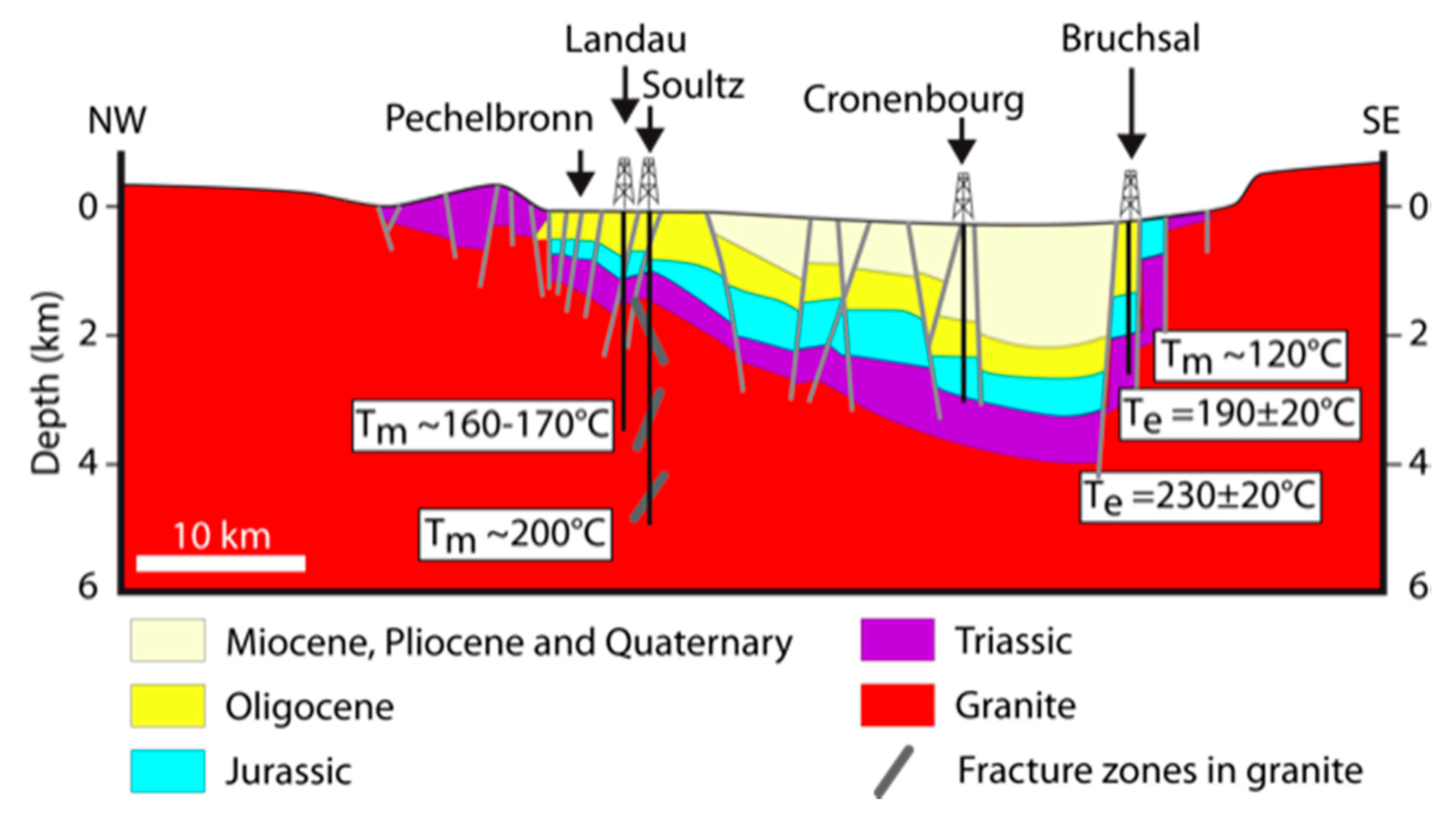

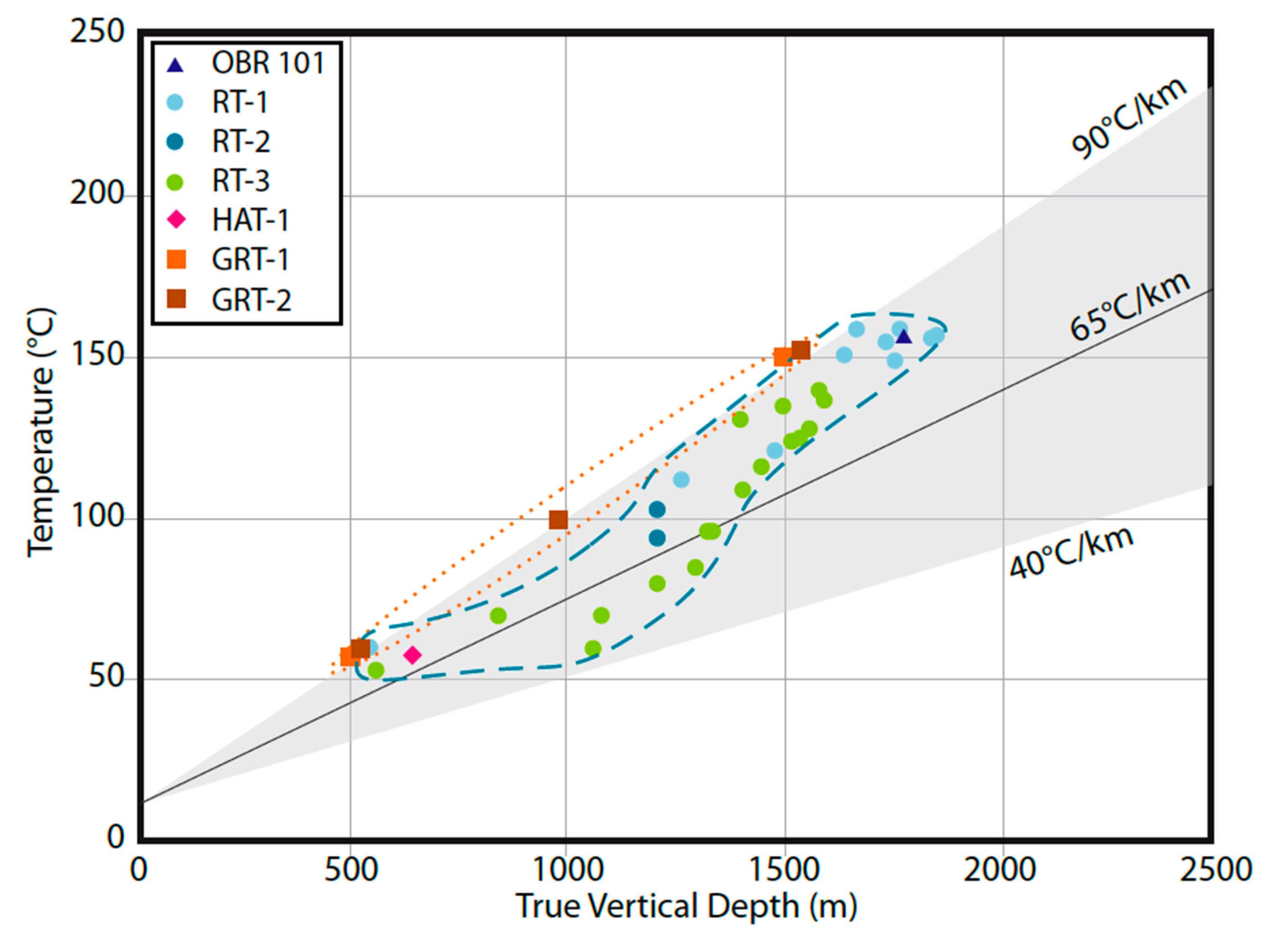
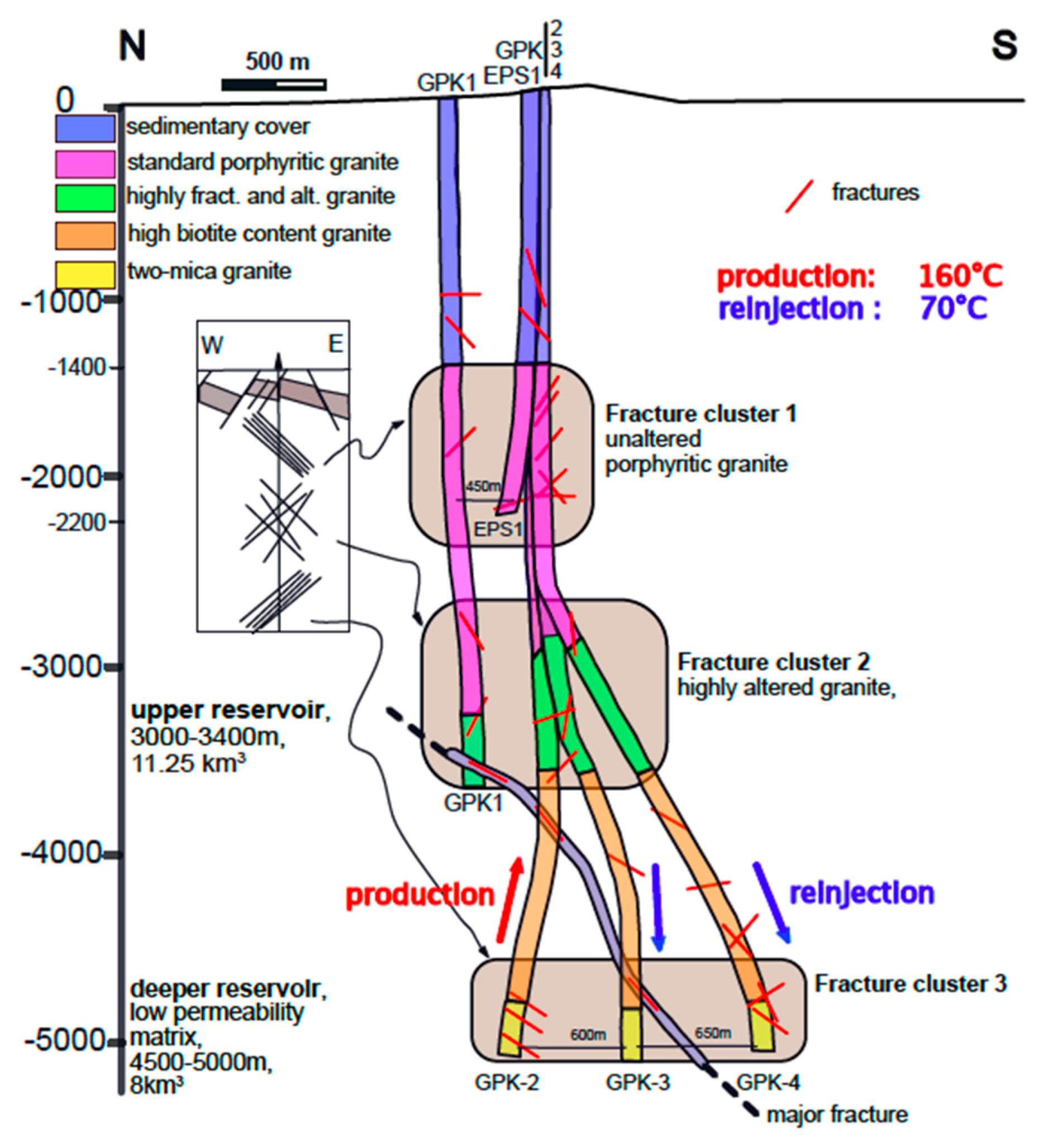


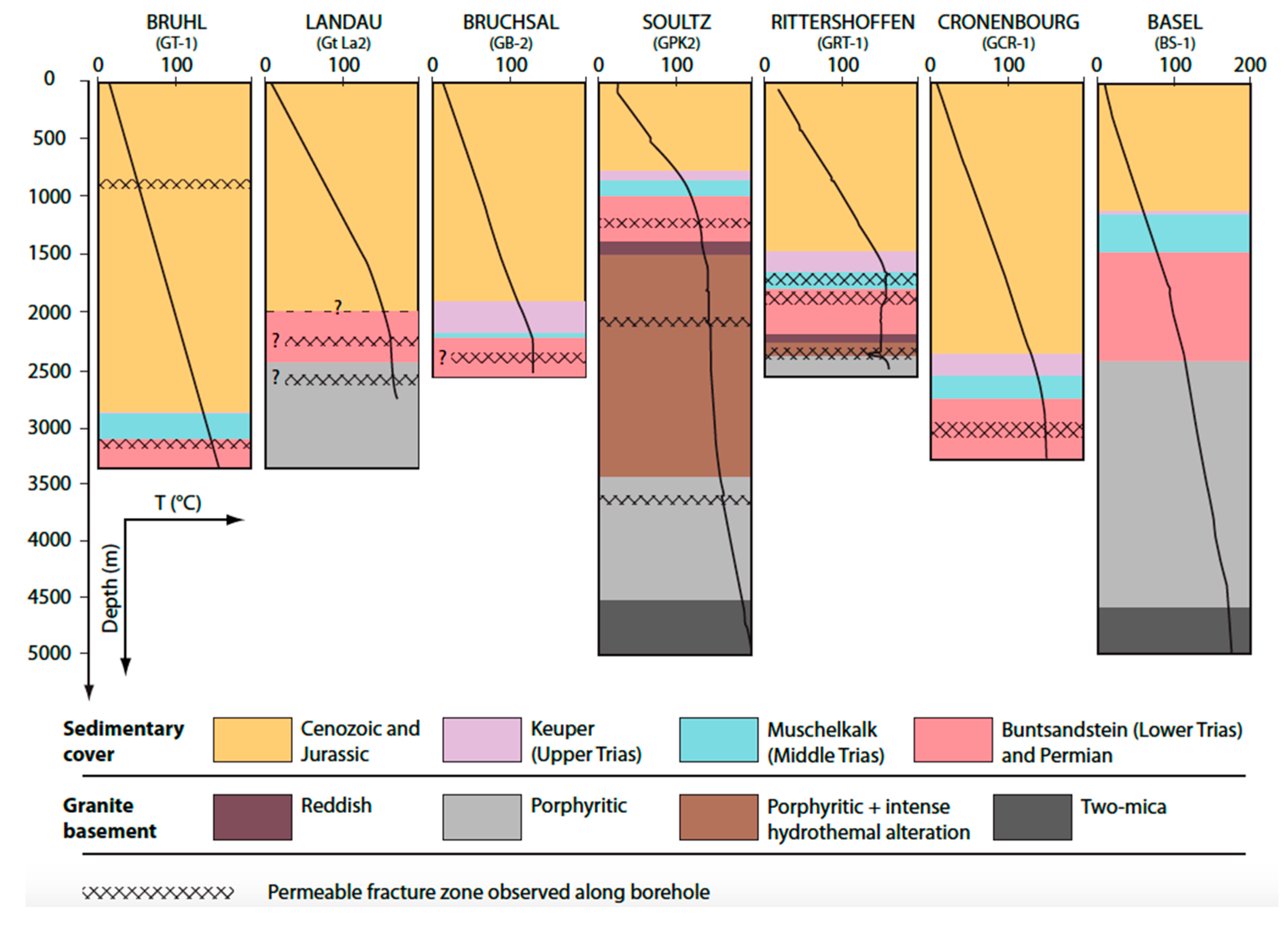

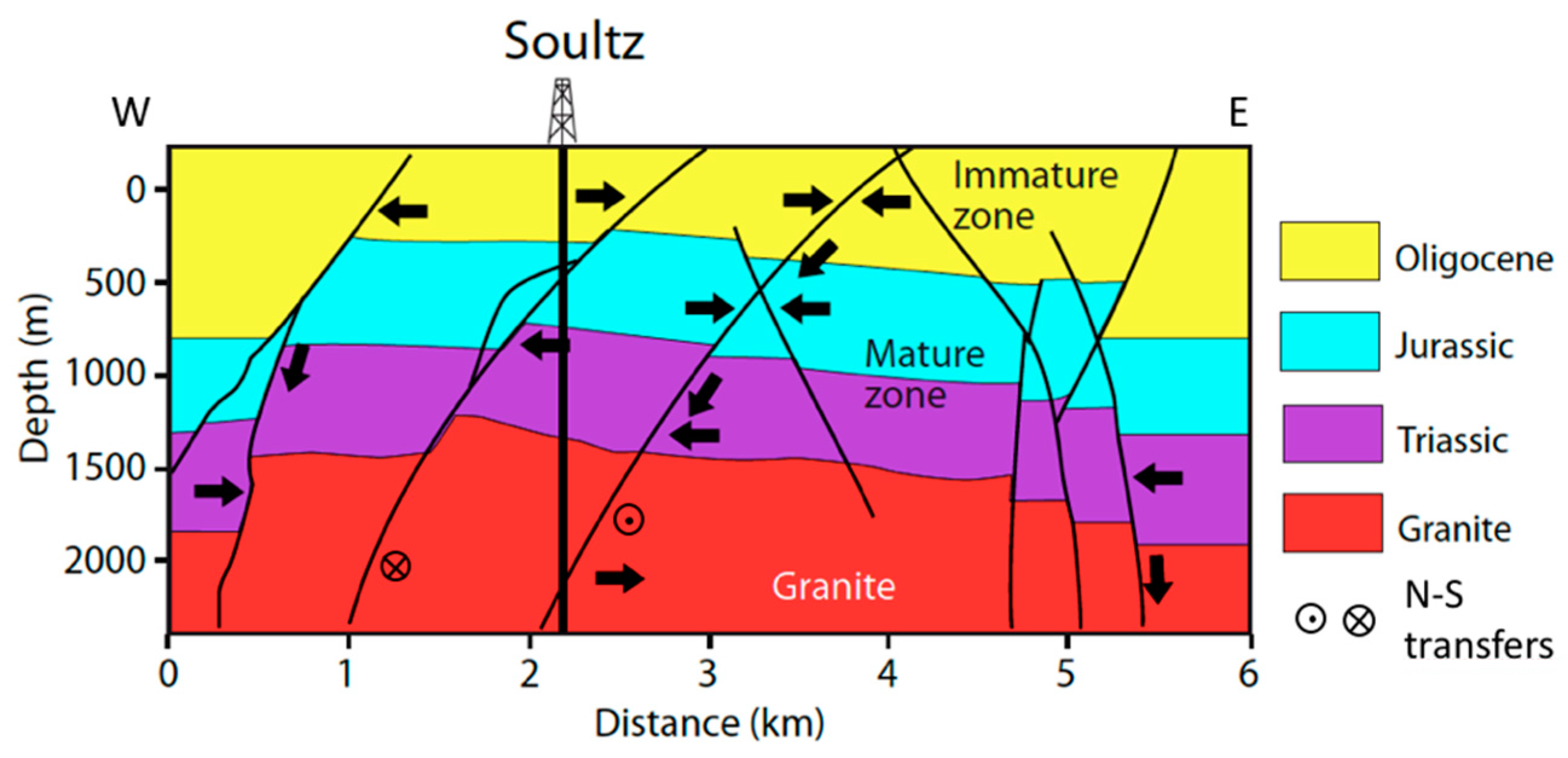
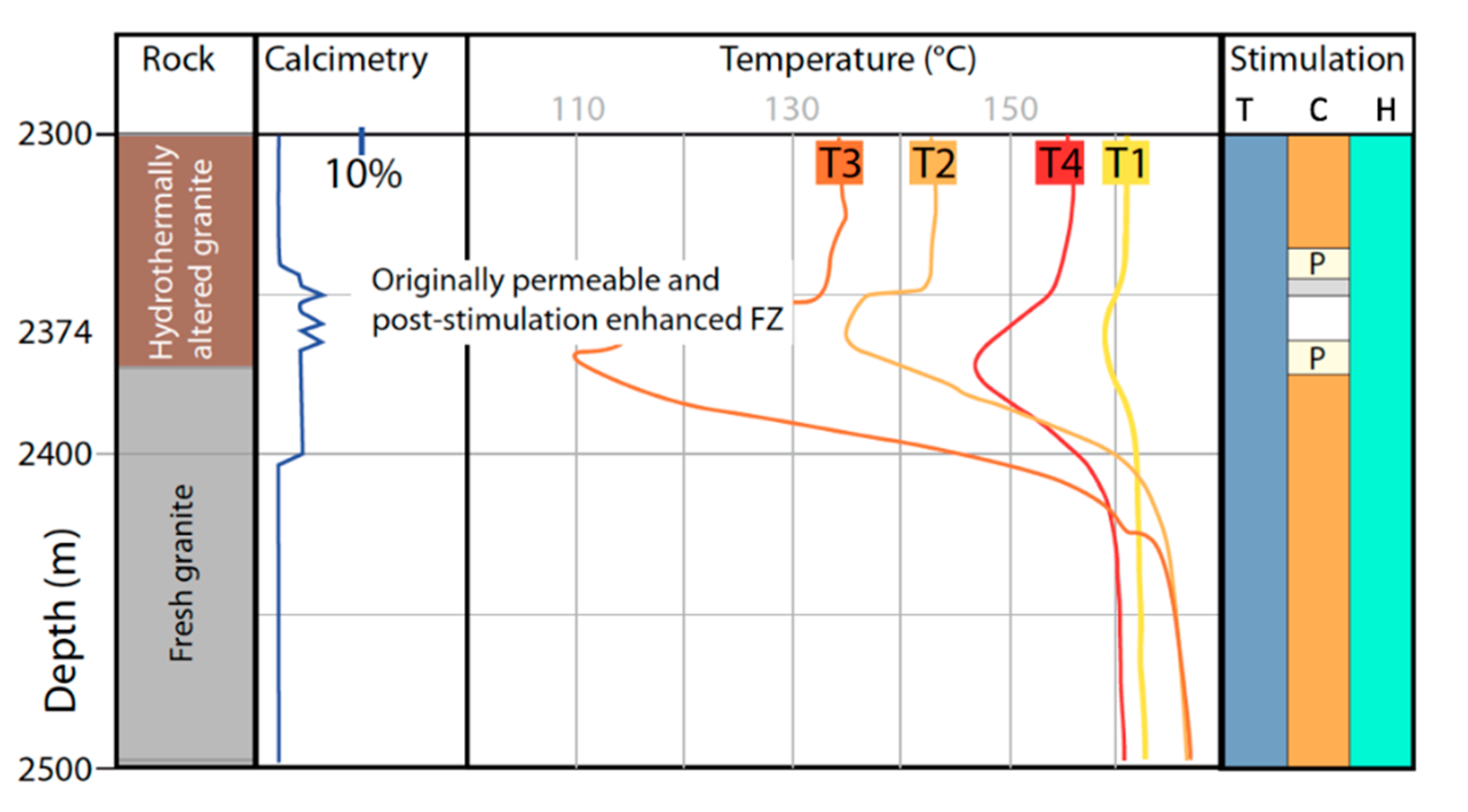
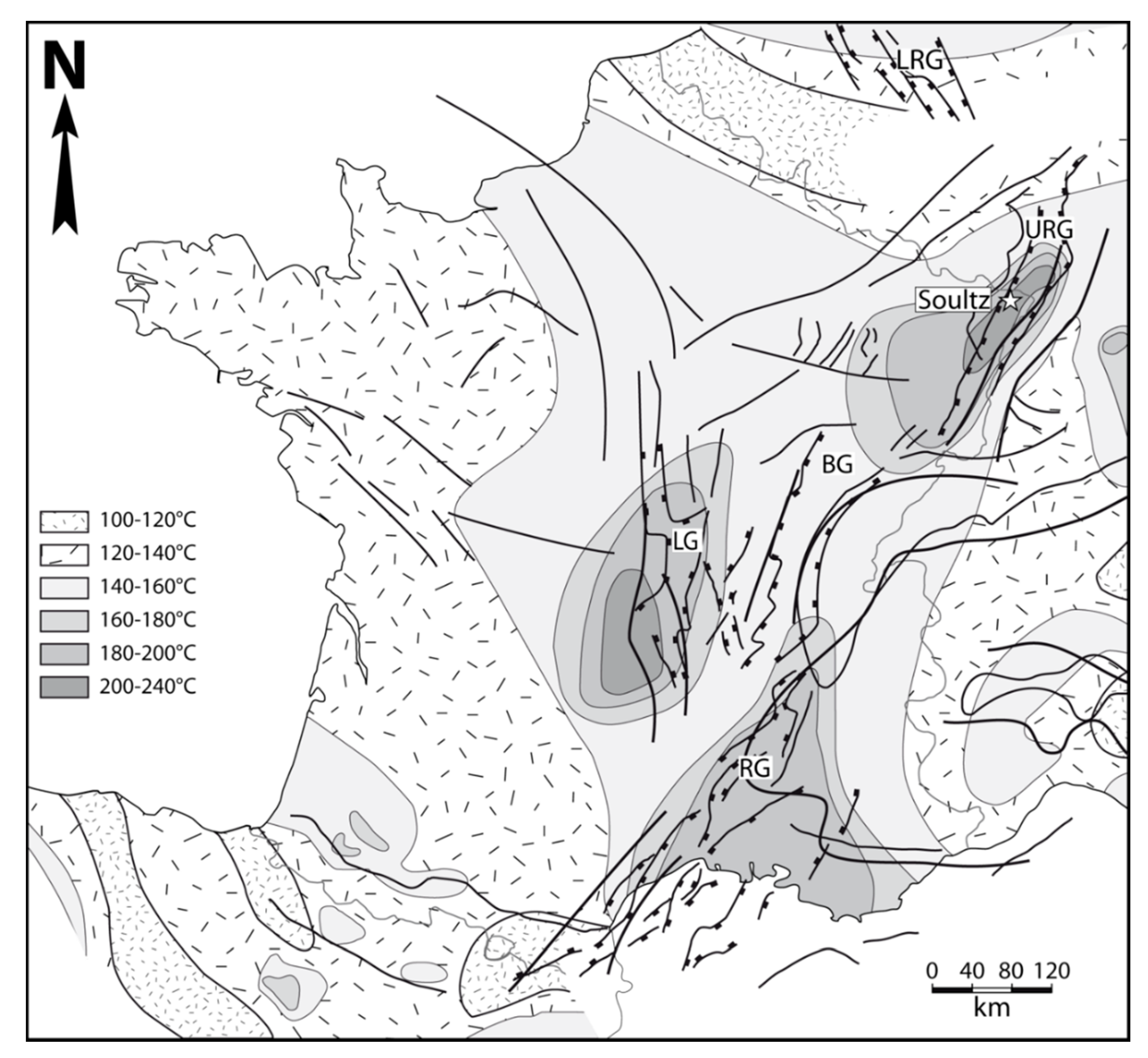
| Geothermal Site | Temperature in °C | Temperature in °C |
|---|---|---|
| (Base of Triassic) | (Bottom Hole in Granite) | |
| Soultz | 120 (1400 m) | 200 (ca 5000 m) |
| Rittershoffen | 160 (1925 m) | 180 (3200 m) |
| Landau | 160–170 (ca 3200 m) | |
| Insheim | 165 (3620 m) | |
| Basel | 190 (5000 m) |
| Oxides (Weight %) | Reference | Tosudite Alteration | Illite Alteration |
|---|---|---|---|
| Loss on ignition | 0.81 | 4.05 | 7.49 |
| P2O5 | 0.14 | 0.21 | 0.38 |
| SiO2 | 67.30 | 63.80 | 54.80 |
| Al2O3 | 15.97 | 15.93 | 21.92 |
| Fe2O3 | 2.08 | 3.09 | 2.51 |
| CaO | 1.47 | 2.52 | 2.68 |
| MgO | 0.88 | 1.06 | 1.05 |
| Na2O | 3.57 | 1.50 | 0.57 |
| K2O | 6.52 | 6.55 | 6.70 |
| TiO2 | 0.40 | 0.56 | 0.99 |
| MnO | 0.07 | 0.08 | 0.16 |
| Density | 2.66 | 2.47 | 2.00 |
Publisher’s Note: MDPI stays neutral with regard to jurisdictional claims in published maps and institutional affiliations. |
© 2020 by the authors. Licensee MDPI, Basel, Switzerland. This article is an open access article distributed under the terms and conditions of the Creative Commons Attribution (CC BY) license (http://creativecommons.org/licenses/by/4.0/).
Share and Cite
Ledésert, B.A.; Hébert, R.L. How Can Deep Geothermal Projects Provide Information on the Temperature Distribution in the Upper Rhine Graben? The Example of the Soultz-Sous-Forêts-Enhanced Geothermal System. Geosciences 2020, 10, 459. https://doi.org/10.3390/geosciences10110459
Ledésert BA, Hébert RL. How Can Deep Geothermal Projects Provide Information on the Temperature Distribution in the Upper Rhine Graben? The Example of the Soultz-Sous-Forêts-Enhanced Geothermal System. Geosciences. 2020; 10(11):459. https://doi.org/10.3390/geosciences10110459
Chicago/Turabian StyleLedésert, Béatrice A., and Ronan L. Hébert. 2020. "How Can Deep Geothermal Projects Provide Information on the Temperature Distribution in the Upper Rhine Graben? The Example of the Soultz-Sous-Forêts-Enhanced Geothermal System" Geosciences 10, no. 11: 459. https://doi.org/10.3390/geosciences10110459





